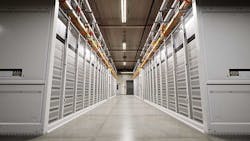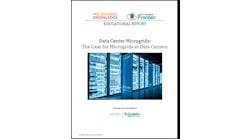Microsoft Taps UPS Batteries to Help Add Wind Power to Ireland’s Grid
Microsoft data centers will soon begin sharing energy from their battery storage systems with Ireland’s power grid, a move designed to help bring more wind energy onto the grid in the energy-constrained Dublin region.
The Microsoft strategy, outlined last week in a blog post, is part of a movement for data centers to collaborate more closely with utilities to help both industries address a challenging energy landscape.
Most data centers house large banks of batteries to support UPS (uninterruptible power supply) systems that condition power. In the event of an outage on the local utility grid, the batteries provide power to the IT systems, typically until backup generators start up and carry the load.
“We have this battery asset in the datacenter that is just sitting there,” said Christian Belady, distinguished engineer and vice president of Microsoft’s datacenter advanced development group. “Why don’t we offer it to the grid and come up with a dynamic way of managing it as a dual-purpose asset and thus drive more efficiency and asset utilization? That’s what drove this win-win situation.”
Grid Interaction Offers Benefits
To accomplish this, Microsoft is using a “grid-interactive” UPS system from Eaton, which monitors and supports the data center power systems, but can also share energy back to the power grid.
Microsoft has been researching the potential of grid-interactive UPS systems since 2017. THis led to proof-of-concept experiments in 2020 at a Microsoft datacenter in Chicago, and follow-up testing at Microsoft’s datacenter in Quincy, Washington.
“We are making sure that we can provide the exact functionality of the UPS and, at the same time, provide ancillary services back to the grid with secure communication between the datacenter and the utility,” said Ehsan Nasr, a senior design researcher who works in Microsoft’s datacenter advanced development group.
The next step was to seek out a region where these battery systems can have a positive impact on the local grid. That led to Ireland, which is seeking to add more renewable energy to its grid. Ireland has 400 wind farms that supply about 35 percent of the country’s power. Since these generation sources fluctuate along with the wind, the Irish grid must balance the volume of power flowing on and off its systems.
How the Dublin Project Works
In 2019, Eaton began a pilot program in which its UPS systems contributed power to the Irish grid, working with EirGrid and energy services firm Enel X in a program known as Energy Aware. EirGrid, the transmission system operator in Ireland, runs a market for grid services that prioritizes non-carbon-emitting solutions.
Microsoft is now participating in this market through Enel X, which aggregates industrial and commercial energy consumers into “virtual power plants” that can be used to balance power and stabilize the grid.
The net effect is that improved grid stability makes it easier for EirGrid to integrate wind power onto the Irish grid. The UPS operator, like any power provider, is compensated for the energy they contribute to the grid. These programs offer the flexibility to use assets on the owner’s schedule, with hourly bidding plans allowing UPS owners to choose the exact hours of participation.
But the economics of these arrangements will vary for the data center operator. These strategies are best suited to UPS systems using lithium-ion batteries. In addition, the potential degradation of batteries will differ between technologies and geographic markets, as noted in a white paper from Eaton exploring the details of its work with Microsoft.
“In some markets, such as in Ireland and the Nordics, grid-interactive operation can have a minimal impact on battery degradation due to the operation plan and payment method,” Eaton notes in the white paper, “while in electricity markets such as PJM in the U.S. or in continental Europe, the battery degeneration has a significant impact on the total cost of ownership. Battery degradation modeling is challenging and requires detailed development and several experimental tests, verified by a third-party laboratory, to define the degradation curves.”
Uptime Remains Job One for UPS Systems
Data center managers tend to be resistant to new strategies that have the potential to impact uptime or make facilities less resilient. Eaton notes that controllers for its grid-interactive UPSes can be programmed to align with reliability strategies.
“When using their batteries in parallel with the power grid, UPSs can revert full power back to the rectifier, or batteries, should the other circuit fail,” the white paper notes. “Equally, a UPS can estimate the remaining energy in batteries and allocate enough capacity for the critical load, preventing the batteries from being discharged beyond defined limits.
“When external signals are used to control the power and state of charge (SoC) of batteries, the failures in communication or external controllers must be detected and managed properly by a UPS. In case of abnormal conditions (alarm) in a UPS, the UPS will fail-safe to a normal operation mode, focusing solely on load protection.”
Microgrids and Grid Services
The Dublin project is just one of Microsoft’s initiatives to work more closely with grid operators. Last month Microsoft said it will partner with Enchanted Rock to use a microgrid at a new data center in San Jose, Calif., which will run on renewable natural gas (RNG) instead of diesel fuel to power its emergency backup generators.
Microgrids provide access to multiple energy sources – the utility grid, energy storage, generators, solar or wind energy – and can allow data centers can operate independently of the grid during outages and times of crisis. Microgrids offer the potential to add new generation sources for primary or backup power, with a controller that manages the different energy sources.
Enchanted Rock will also offer grid services, which could include running generators to offset load on the utility grid, or even to generate surplus power to sell to the grid operators.
Google is also looking at new market models for working with utilities on the grids where the company operates data centers, including in Belgium, where the company is using large batteries to replace the diesel generators at one of its data centers.
“Whereas diesel generators sit idle most of the year, batteries are multi-talented team players: when we’re not using them, they’ll be available as an asset that strengthens the broader electric grid,” said Joe Kava, Vice President for Data Centers at Google.
“Providing grid services “is a way for us to unlock the value of the datacenter,” said Nur Bernhardt, a senior program manager for energy at Microsoft. ‘“We can still maintain our requirements around reliability to our customers but at the same time utilize our infrastructure to provide reliability to the grid, as well as lower CO2 emissions and reduce costs for all energy consumers.”






